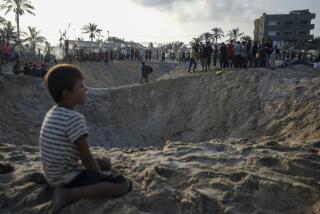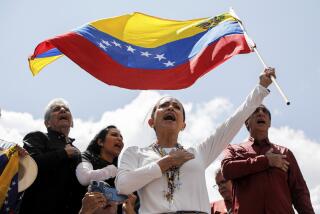Pressure to Remove Saddam Hussein Builds
- Share via
WASHINGTON — The Clinton administration faces growing pressure to end the protracted and costly confrontation with Iraq the simple way--by getting rid of Iraqi President Saddam Hussein, the man who started it all.
Congressional leaders this week have called for it. Columnists of both the left and the right are clamoring to take him out. Washington power brokers--including a former CIA director and defense secretary--have written the White House urging a new strategy to remove him.
And opinion polls show that, almost 4-to-1, the American public favors a U.S. military strike designed to eliminate Hussein, not just force his compliance with an international disarmament regime.
But the most efficient strategy may be the hardest, and, barring a military miracle, Hussein is likely to still be in power--and a threat--when this impasse is over.
The most basic obstacle to removing him is mandate. The United States doesn’t have it.
“That is not what the United Nations has authorized us to do. That is not what our immediate interest is about,” President Clinton said Thursday.
Weary of a problem that has already cost billions of dollars and repeatedly diverted global attention from pressing problems of the post-Cold War world, Washington would clearly like to have the option.
But the focus in the current confrontation is limited.
“Our interest is in preventing Saddam Hussein from building biological, chemical, nuclear weapons capability [and] the missiles to deliver such weapons,” the president said.
Yet from the beginning, the “What to do about Saddam?” question has loomed--and grown ever larger with each passing year and new dispute. Since Iraq invaded Kuwait in 1990, the United States, its allies and the Iraqi opposition have tried or considered five disparate strategies to rid the region of its most lethal threat.
But each is fraught with difficulties:
* Assassination: This most obvious tactic is illegal. In 1976, President Ford issued Executive Order No. 12333, which said: “No person employed by or acting on behalf of the United States government shall engage in, or conspire to engage in, assassination.” The simple 22-word edict was issued after a CIA report revealed that presidents Eisenhower, Kennedy, Johnson and Nixon were involved in plots or coups against eight foreign leaders in regions ranging from Africa to Southeast Asia to Central America.
Congressional officials Thursday suggested changing the law. But removing Hussein has not proved any easier for internal opponents--who are not bound by such restrictions--despite dozens of attempts.
The Iraqi leader takes extreme security measures, rotating his protective force as well as his inner political circle to limit access; he employs doubles to stand in for him at public events.
* Military assault: This option is the most costly--in human, financial and political terms. U.S. analysts over the years have estimated that a military operation to change the Iraqi regime would require hundreds of thousands of ground troops as well as a display of air power so vast it would dwarf “Operation Desert Storm.”
It would mean sweeping into Baghdad, and possibly would prompt Hussein to use chemical and biological weapons. Large numbers of casualties would be likely.
Unlike in the 1991 Persian Gulf War, the United States would now probably have to go it alone. Most former coalition partners are already reluctant about a limited U.S. airstrike. The political cost of ousting Hussein could seriously hurt U.S. stature and credibility elsewhere in the world.
* Covert operations: This is the most probable option but also the most susceptible to Iraqi penetration and disruption.
The largest CIA operation since the Afghan war was in Iraq. For six years, tens of millions of dollars were poured annually into the Iraqi National Congress, a coalition of Kurds and Sunni and Shiite Muslims based in northern Kurdistan. The coalition’s mission was to destabilize and potentially replace the regime. The CIA also ran one of its biggest stations in northern Iraq. But both the INC and CIA were forced out in a lightning military strike by Hussein’s troops in 1996, on the pretext of stopping clashes between Kurdish rivals.
A separate CIA-backed plot to overthrow Hussein from within the ranks of his Republican Guard was uncovered in 1996. The plot’s lone “success” was a small bomb detonated in one of his palaces--minutes after he left.
Iraq’s draconian intelligence network has consistently prevented significant CIA penetration of Hussein’s inner circle--and cultivation of political operatives or alternatives.
* Internal uprising: This would be the most preferable. Days after the Persian Gulf War’s end, northern Kurds and southern Shiites simultaneously launched uprisings. But the U.S.-led coalition let Iraq retaliate with its air power, the key in Baghdad’s swift, deadly response.
The coalition then feared that Iraq might fragment into three ethnic-based parts, with a rippling, divisive effect across the region. “No-fly” zones have since been imposed on northern and southern Iraq. None of the dissident movements inside have been able to recoup and remobilize.
* War crimes prosecution: This is the longshot. While preparing for war in “Operation Desert Shield,” the Pentagon began accumulating material, from individual human rights abuses to violations of international accords, for possible war crimes prosecution.
The documents, interviews and other evidence were vast. But the Bush administration shelved the case as unrealistic.
Although it might provide a legal basis to seize Hussein, the case also might be more difficult to prosecute more than seven years later.
Congressional officials acknowledged Thursday the obstacles to ousting Hussein.
Any attempt to remove him “would not be a Noriega operation, where you’d just go in and get him,” said Sen. John McCain (R-Ariz.), referring to the U.S. capture of former Panamanian strongman Manuel Noriega.
That 1989 mission took 24,000 U.S. troops and resulted in the deaths of at least 500 Panamanians, cost the lives of almost two dozen U.S. service personnel and took at least four days in a 20-square-mile city. Iraq is 168,000 square miles (a little larger than California).
Yet the call for a strategy shift aimed directly at Hussein is growing louder, as reflected in a letter to Clinton signed by 18 powerful Washington figures and calling for a “full complement of diplomatic, political and military efforts” to remove Hussein and those around him.
R. James Woolsey, Clinton’s first CIA director and one of the signers, added in an interview: “Our support for Iraqi democracy ought to be like our support for [Poland’s] Solidarity and other liberation movements during the Cold War. Saddam’s days, months or years are numbered, but it will take a sense of commitment and work on our part to see that someday there is a change.”
* ROUND 2? A look at the roots of the latest clash with Saddam Hussein. A5
* MORE FORCES: 2,000 Marines are ordered to Gulf by President Clinton. A8
More to Read
Sign up for Essential California
The most important California stories and recommendations in your inbox every morning.
You may occasionally receive promotional content from the Los Angeles Times.












